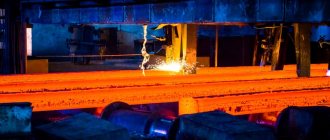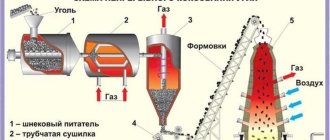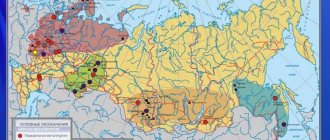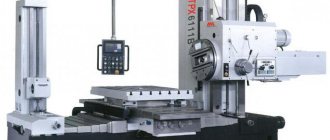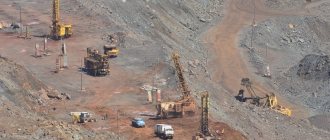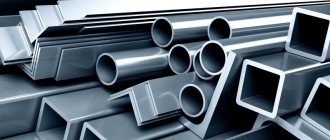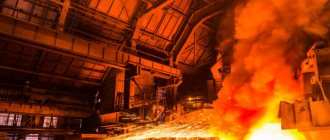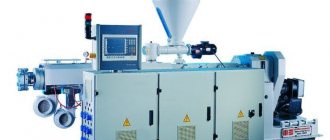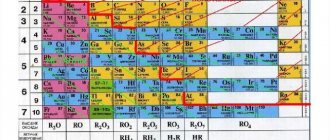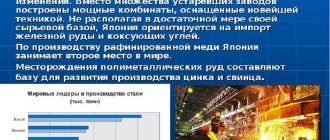The power and prosperity of the state depends on the efficiency of the economy and military potential. The development of the latter is impossible without the development of metallurgy, which in turn is the basis of mechanical engineering. Today the focus is on the metallurgical complex of Russia and its importance for the industrial and economic sphere of the country.
General characteristics of the metallurgical complex
What are mining and metallurgical complexes? This is a set of enterprises that are engaged in mining, beneficiation, metal smelting, rolled metal production and processing of secondary raw materials. The following industries are part of the metallurgical complex:
- Ferrous metallurgy , which deals with the smelting of steel, cast iron and ferroalloys;
- Non-ferrous metallurgy , which produces light (titanium, magnesium, aluminum) and heavy metals (lead, copper, tin, nickel).
Rice. 1 Metallurgical plant
Principles of business location
Enterprises of the mining and metallurgical complex are not located randomly. They depend on the following factors of metallurgy location:
- Raw materials (physical and chemical characteristics of ores);
- Fuel (what type of energy must be used to produce metal);
- Consumer (geography of placement of raw materials, main energy sources and availability of transport routes).
Rice. 2 Fuel factor of metallurgy location
Main metallurgical bases
All of the above factors led to the uneven distribution of metallurgical enterprises. Entire metallurgical bases were formed in certain territories. In Russia there are three:
- The central base is a fairly young center, the foundation of which is the iron ores of the Kursk magnetic anomaly region, the Kola Peninsula and Karelia. The main production centers are the cities of Lipetsk, Stary Oskol and Cherepovets;
- The Ural base is one of the largest centers of metallurgy in Russia, the main centers of which are Magnitogorsk, Novotroitsk, Chelyabinsk, Nizhny Tagil and Krasnouralsk;
- The Siberian base is a center that is still in the development stage. The main source is Kuznetsk coal and iron ore from the Angara region and Mountain Shoria. The main center is the city of Novokuznetsk.
A comparative description and operating diagram of metallurgical bases in Russia can be presented in the following table:
| Central | Siberian | Ural | |
| Iron ores | Kursk magnetic anomaly, Kola Peninsula, Karelia | Angara region, Mountain Shoria | Ural Mountains |
| Coking coal | Privoznoy (Donetsk and Kuznetsk coal basin) | Local (Kuznetsk coal basin) | Privoznoy (Kazakhstan) |
| Enterprises | Full cycle enterprises (produce cast iron, steel, rolled products) | Full-cycle and marginal metallurgy enterprises (produce only steel and rolled products) | Full cycle enterprises (produce cast iron, steel, rolled products) |
Metallurgical bases of Russia
Depending on the focus of the metallurgical complex, enterprises are located close to the sites of extraction of raw materials necessary to ensure their operation. Since deposits of ore, or fuel for its smelting, are located in certain regions of the country, there are entire groups of metallurgical plants and combines around them. These enterprises use common raw materials and have the same production direction, so they are conventionally combined into groups called metallurgical bases. On the territory of Russia three large groups can be distinguished:
- Central - Ural - Siberian.
Since these territories contain ore deposits of different composition, different degrees of supply with fuel and other production needs, the target orientation, capacity and structure of the bases are different. In addition, in these regions, mining and processing started at different times, which significantly affected not only the scale of production capacity, but also the depletion of the mines from which mining is carried out.
Central metallurgical base
This group of enterprises is engaged in active production of ferrous metals. The resource of these enterprises is very large, since nearby territories have significant reserves of raw materials in the form of iron ore. Production covers not only the smelting of extracted ore from the deposits of the Kursk magnetic anomaly, but also processes imported raw materials and ferrous metal scrap.
The territory of the Central Base is characterized by the occurrence of ore quite close to the surface, which made it possible to establish open-pit mining.
This technology allows for greater productivity in each mine. This significantly reduces the cost, which has a positive effect on the development of the entire metallurgical complex of the Central Base.
Direct production is carried out in the Kursk and Belgorod regions. The cost of production is 1 ton. of ore ready for processing is almost two times lower than at other production deposits in Ukraine and Kazakhstan. The central base provides 80 million tons. raw ore.
This figure accounts for about 40% of production throughout the country. Its convenient location allows us not only to export our products, but also to import raw materials for processing. These facts have a positive effect on the cost of production, making it competitive in the market.
The group includes enterprises of a full metallurgical cycle, which are equipped with production capacity for processing raw materials into finished products in the form of rolled metal and other products. Among them are: Novotula plant, Novolipetsk metallurgical plant, metallurgical plant, Oskol electrometallurgical plant for direct reduction of iron. These enterprises have a high degree of self-sufficiency and play a key role in the Russian economy.
The central base also includes the territory of the North of the European part of the Russian Federation. There are ore deposits here amounting to 5% of the total reserves. Direct metal extraction as a percentage of the All-Russian is 21%. This is provided by a group of enterprises such as: Cherepovets Metallurgical Plant, Olenegorsk, Kovdor and Kostomuksha Mining and Processing Plants. The ore mined here has a small percentage of impurities, which allows it to be processed into high-quality high-carbon steel.
Ural metallurgical base
It has a developed structure, which allowed it to become one of the largest metalworking complexes in the CIS countries. Every day, 52% of cast iron and ferrous metals, 56% of steel of the total productivity in the country are smelted here. The largest production of non-ferrous metals in the Russian Federation has been established in the Urals. Such scale is explained by the fact that these industries are the oldest in Russia, so they have a long history of development. Due to the shortage of fuel in this region, the supply of Kuznetsk coal has been established, which allows it to fully cover demand. Due to the severe depletion of their own deposits, enterprises process ore from Kazakhstan, Karelia and the Kursk magnetic anomaly. These measures allow Ural metallurgy to maintain its leadership in productivity.
Direct mining of own ore is actively taking place in the Sverdlovsk and Chelyabinsk regions. Large-scale production has been established at the Kachkanar Mining and Processing Plant and the Bakal Mining Administration. These enterprises are quite old and have a long history, and have been supporting the work of the entire region for many years.
The most effective centers of the country's ferrous metallurgy are located precisely in the Urals, these are: Magnitogorsk, Nizhny Tagil, Chelyabinsk, Serov, Yekaterinburg, etc. It should be noted that the largest iron production enterprise in Europe is the Magnitogorsk Iron and Steel Works, which is also part of the Ural Metallurgical Group bases. The Urals are characterized by a high concentration of these enterprises. But their activities are not limited to smelting, since the region produces pipes for oil and gas pipelines, which is a large area that requires a significant share of the metals produced. Thus, on the territory of the Ural base, a system of metal consumption has been developed by manufacturing pipes, fittings and other products from it, which cover demand not only within the country, but are also exported.
Siberian metallurgical base
This is a relatively young group that is at the formation stage. Despite the insignificant degree of development, in comparison with Ural enterprises, mining and processing activities are very promising. 21% of the country’s total reserves are hidden in the bowels of the earth in this region, and there are not yet very many factories and plants for their extraction. As a percentage, 15% of cast iron and finished rolled products are produced. The operation of the enterprises is ensured by the Angaro-Ilim basin, Khakassia and Mountain Shoria. For smelting, fuel is used from the Kuznetsk coal basin, which, as noted earlier, supports Ural production.
The main ones in the region are the Kuznetsk and West Siberian metallurgical plants. Due to the incomplete filling of the raw material extraction capacity, there are prospects for the construction of additional centers on the territory of the Siberian Metallurgical Base. In particular, this can be done by expanding the Taishet and Barnaul metallurgical plants.
In light of the active formation of the South Yakut complex, there are prospects for the development of this activity in the Far East. The remoteness of the region is an obstacle to large-scale transportation of raw materials, so it is planned to create a full processing cycle directly near the extraction site. This will reduce the cost of finished products, since there will be no need for additional transportation costs.
With the development of the economy, associations and holdings were formed to ensure the sale of products and the supply of raw materials necessary for production from other regions or countries. Their structure includes factories and combines, which are located in different metallurgical bases of the country. Vivid examples of such a union are the Metalloinvest holding, Severstal, Evraz Group S.A. and etc.
Non-ferrous metallurgy
Based on their purpose and chemical and physical characteristics and properties, non-ferrous metals are divided into:
- Heavy (copper, lead, tin, zinc, nickel);
- Lightweight (aluminum, titanium, magnesium);
- Precious (gold, silver, platinum);
- Rare (zirconium, indium, tungsten, molybdenum, etc.)
Non-ferrous metallurgy is a complex of enterprises that is engaged in the extraction, enrichment and metallurgical processing of non-ferrous, precious and rare metal ores.
In this chain, aluminum, copper, lead-zinc, tungsten-molybdenum and titanium-magnesium industries are distinguished. In addition, this also includes enterprises producing precious and rare metals.
Features of the raw material base of the domestic non-ferrous metallurgy.
The raw materials of non-ferrous metallurgy in Russia have a number of features that determine the main characteristics of the industry as a whole.
- Ores containing non-ferrous metals are characterized by a low content of useful components. For example, copper ore mined today contains only one to five percent copper, and molybdenum ore contains even less molybdenum - from 0.005 to 0.04%, which is considered an extremely low level. In simpler terms, in order to obtain one ton of copper, it is necessary to process about 100 tons of copper ore itself, that is, to produce one ton of finished products, you have to spend hundreds or even thousands of times more raw materials. And this cannot affect the cost of finished products.
- All ores mined on our territory have a multicomponent structure. Sometimes the number of useful elements in the ore mined at one deposit can reach 30. An example here is the Ural copper pyrites, which, in addition to copper itself, also contain components such as iron, sulfur, gold, silver, cadmium and others.
- Processing ores mined in our country requires large amounts of fuel and electricity. For example, in order to process nickel ore and produce 1 ton of finished products from it, up to 55 tons of fuel may be required. As for energy consumption, quite impressive examples can be given here: for example, to produce 1 ton of titanium, it is necessary to consume up to 60 thousand kW. hours of electricity, and for the production of 1 ton of aluminum - up to 17 thousand kW. h.
Non-ferrous metallurgy centers in Russia
The centers of the aluminum industry are Bratsk, Krasnoyarsk, Sayansk and Novokuznetsk. Large aluminum smelters located in these cities are developed on the basis of their own raw materials from the Urals, the North-Western region and Siberia, as well as imported ones. This production is quite energy-intensive, so the enterprises are located near hydroelectric and thermal power plants.
The main center of the copper industry of our country is the Urals. Enterprises use local raw materials from the Gaisky, Krasnouralsky, Revdinsky and Sibaysky deposits.
The country's lead-zinc industry depends on the extraction of polymetallic ores, which is why it is located close to their mining sites - Primorye, the North Caucasus, Kuzbass and Transbaikalia.
Rice. 3 Gold mining in Chukotka
Location of non-ferrous metallurgy enterprises in Russia.
The location of non-ferrous metallurgy enterprises on the territory of our country is mainly influenced by the characteristics of the raw material base of this industry. Since non-ferrous metallurgy is a material-intensive industry, the location of industrial enterprises depends largely on where the raw material base for their work is located. Very often, for example, ore is enriched directly at the site of its extraction - the only exceptions here are deposits near which there are no water sources. The fact is that ore beneficiation requires the use of large amounts of water. For example, to enrich a ton of copper-nickel ores, 8 to 10 thousand cubic meters of water may be required.
Another feature of the raw material base of non-ferrous metallurgy, which affected the layout of industrial enterprises, is its high energy intensity. That is why enterprises in this industry, for the most part, are located in regions that do not lack electricity.
Based on all these features, it is not surprising that the main non-ferrous metallurgy enterprises are located in the Urals, as well as in the Northern and Northwestern regions of our country. And in the last few years, non-ferrous metallurgy has also been actively developing in Eastern Siberia and the Far East. In general, speaking about the Far East, it is worth noting that non-ferrous metallurgy is one of the most developed and efficient industries there today - the majority of tin ores, gold, lead and mercury in Russia are mined here.
Problems and prospects
There are problems in every industry. The metallurgical complex is no exception. Among the main problems of ferrous and non-ferrous metallurgy, the following can be identified:
- high energy consumption;
- low capacity of the domestic market;
- high level of depreciation of fixed production assets;
- shortage of certain types of raw materials;
- destruction of the process of reproduction of raw materials and ore reserves;
- technological backwardness and insufficient introduction of new technologies;
- shortage of professional personnel.
But all these issues can be resolved. Russia continues to be a major player in the global metallurgical products market. The share of Russian metallurgy in world production accounts for more than 5% of steel, 11% of aluminum, 21% of nickel, and more than 27% of titanium. The main indicator of the competitiveness of Russian metallurgy on the foreign market is that the country maintains and even expands its export capabilities.
What have we learned?
Today we learned what is meant by the term “metallurgical complex”. This industry is divided into ferrous and non-ferrous metallurgy. The location of enterprises for mining, ore beneficiation, metal smelting and rolled products production has its own characteristics and depends on three factors: raw materials, fuel and consumer. There are three metallurgical bases operating and developing in the Russian Federation: Central, Ural and Siberian.
Previous
GeographyForest industry in Russia and the world, location factors and problems
Next
Geography Factors for the location of the chemical industry - table
so UNT / Geography / Lesson plans for geography 10th grade
Lesson 24. Non-ferrous metallurgy
24.08.2014 19357 0
Objectives: to form an idea of the location of non-ferrous metallurgy enterprises; determine factors for the location of non-ferrous metallurgy plants, identify changes in the location of enterprises in recent decades.
Equipment: map “Non-ferrous metallurgy of the world”, atlases.
During the classes
I. Survey
1. At the meeting in Cherepovets, a world map was demonstrated, on which a number of foreign cities were marked. They contain enterprises with which the leading enterprises of the city are planning to implement joint projects. Think about which cities are marked on this map? (Cities in which there are full-cycle ferrous metallurgy plants operating on imported coal and imported ore, for example, Baltimore, Toronto, etc.)
2. How can we explain the fact that from the creation of ferrous metallurgy plants they are now increasingly moving towards the creation of low-capacity plants?
3. Why in Germany the main centers of ferrous metallurgy were formed in the interior of the country, and in Italy - on the Mediterranean coast? Please provide at least two reasons. Name the centers. (Italy does not have its own raw materials and fuel. The country is forced to purchase raw materials. Therefore, enterprises are located on the coast. For example, Toronto.)
4. Which region of the world is the leader in iron ore mining? For steel production?
5. Which countries in the world export almost all of their iron ore?
6. Highlight the capitals of the two countries with the largest volumes of iron ore exports: Kinshasa, Georgetown, London, Santiago, Pretoria, Kingston, Monrovia, Conakry, Paramaribo.
7. What changes are taking place in the location of ferrous metallurgy enterprises at the present time?
8. Why are developing countries playing an increasingly important role in the smelting of ferrous metals? What stages of the metallurgical cycle are located here?
II. Testing (see appendix)
III. Learning new material
Stages of production of non-ferrous metals
Non-ferrous metallurgy is the oldest industry. It includes several stages: extraction of raw materials, enrichment, metal production, refining of some non-ferrous metals, production of alloys.
Low metal content in ore requires mandatory beneficiation. Since non-ferrous metal ores usually contain a large number of different metals, each component is separated sequentially during smelting.
Enrichment occurs in smelting furnaces, thus obtaining rough metal. But rough metal contains many impurities, so it is refined. Various profiles are obtained from the resulting pure metal.
Factors in the location of non-ferrous metallurgy enterprises The location of non-ferrous metallurgy enterprises occurs under the influence of various factors. Firstly, this is the raw material factor, since to obtain, for example, 1 ton of copper it is necessary to process 100 tons of ore, to obtain 1 ton of tin it is necessary to process 300 tons of raw materials. Secondly, the energy factor, the aluminum industry is a particularly energy-intensive industry. Therefore, aluminum industry plants will be located near power plants; in this case, hydroelectric power plants are especially attractive for the aluminum industry. Recently, the availability of secondary raw materials has been of great importance for the location of non-ferrous metallurgy plants. Remelting produces 1/5 of tin and up to 2/5 of copper. Basic metals in demand by the global economy Currently, non-ferrous metallurgy produces about 62 metals. But the main share falls on copper, aluminum, zinc, and lead. In the second half of the 20th century, the aluminum industry grew at a particularly rapid pace.
Ore mining areas and non-ferrous metals production areas Assignment: Based on the data from the atlas maps, analyze the ore mining areas and non-ferrous metals smelting areas, enter the analysis results in a table. Draw a conclusion about which countries focus on their own raw materials and which rely on imported ones.
III. Conversation following the work
After checking the quality of filling out the table, the teacher suggests comparing countries that mine non-ferrous metal ores and countries that produce pure metal.
1) What pattern can be identified in the location of plants for the production of crude and refined metals? (The stages of mining and beneficiation of ores are more represented in developing countries, this is due to the tectonic features of these territories; it is in developing countries that reserves of non-ferrous metal ores are concentrated. For example, the share of aluminum ores located in developing countries is 1/2, and the share of tin - 4/5 of the world's reserves. Production of pure metal is located mainly in developed countries, since this is a more environmentally friendly production, but also more energy-intensive.)
1) Which developing countries have the top floors of non-ferrous metallurgy production in their countries? (In recent decades, energy-intensive production of non-ferrous metallurgy can be afforded by not very developed countries, such as China, Brazil, Chile.)
2) In which branch of non-ferrous metallurgy the location of production has not changed? (In copper, raw materials are still the main factor in this industry.)
3) Why do China, Brazil, Chile, India, Venezuela locate and develop non-ferrous metallurgy? (This is due to several reasons, firstly, the presence of a raw material base in these countries, secondly, the presence of a fairly developed energy sector, and thirdly, dirty production from developed countries is transferred to these countries.)
4) Which branch of non-ferrous metallurgy is characterized by a gap between the areas of extraction and production of pure metal? {For aluminum.)
5) Why is the share of developing countries in the production of non-ferrous metals growing at an accelerated pace compared to developed countries? (They accept dirty industries from developed countries.)
6) Which country is the undisputed leader in all indicators of non-ferrous metallurgy? {USA.)
V. Homework
1. Having met at the international exhibition “Non-Ferrous Metals”, copper industry specialists from 6 countries started talking about how each of them spends their leisure time at home. Two turned out to be avid skiers, and one of them said that there is snow in the vicinity of the city most of the year and proudly reported that the plant where he works is the northernmost in the world. Two others complained about the constant heat, while one of them complained about the dry climate, and the second about tropical downpours and dampness. It turned out that five of them live near large lakes, however, not all of them swim in them - somewhere it’s too cold, and in two there is salt water (by the way, it turned out that two of them live in cities of the same name as the lakes ). Only one of them boasted that he swims in the ocean on weekends. Another replied that he needed a passport to go to the beach. Three are ski enthusiasts. Two are collectors of minerals, one of them called his peninsula a mineralogical museum, the other assured that his region had recently been a blank spot on the map, and minerals unknown to science could be found here. Representatives of which countries met at the exhibition? What are the names of the cities where they came from? Which of these countries produces the most ore? Which country smelts more metal?
2. Recall from the 9th grade course the importance of the mechanical engineering industry.
